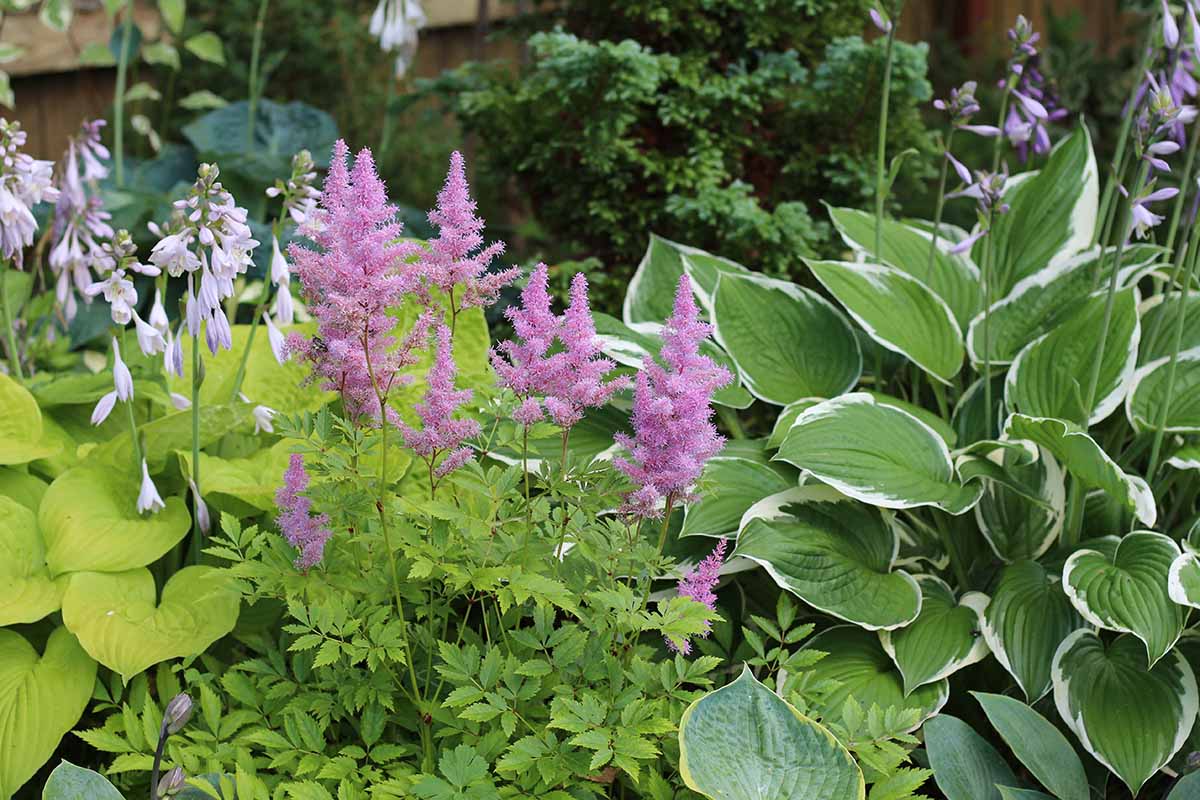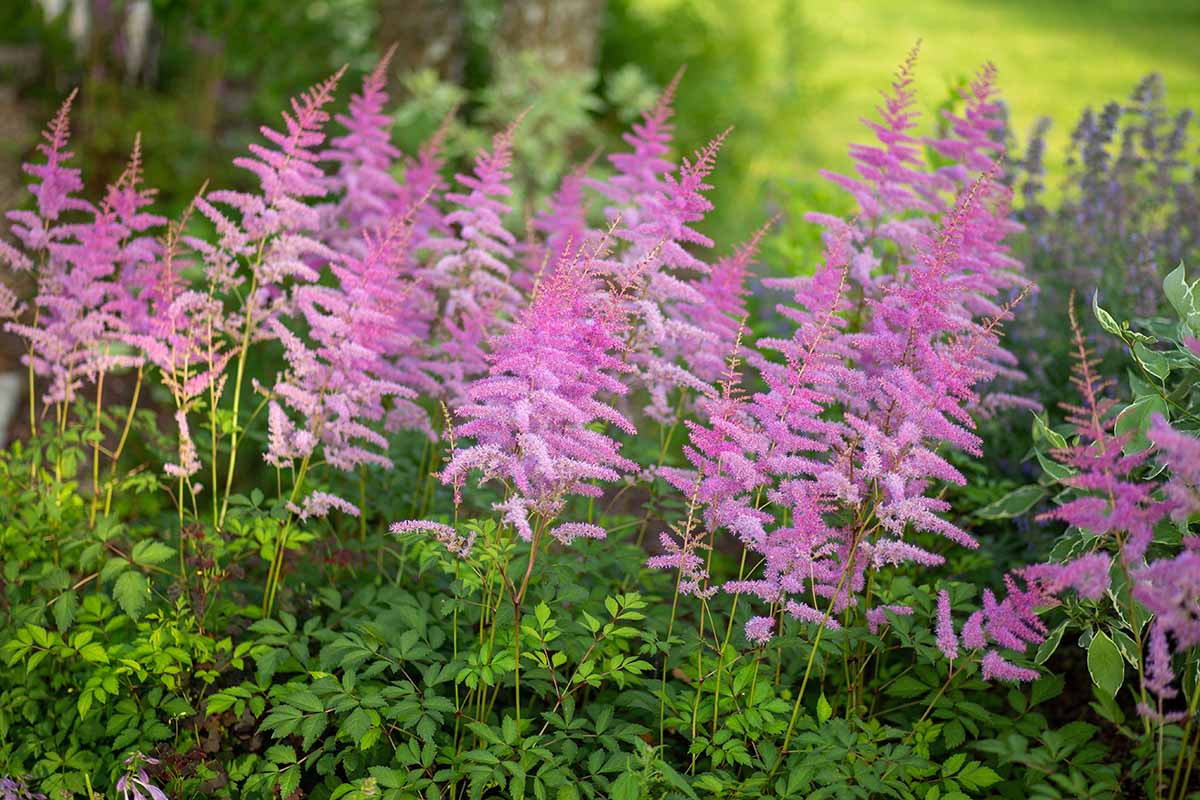It’s easy to forget that flowers don’t need to be in the sun to grow. Many of them do better in the shade.
Exhibit A: astilbe. Some might say that species of Astilbe are the best plants for a shade garden out of all of them.
The foliage itself is visually interesting, but it’s the colorful flowers that really makes astilbe sing.
And as an added bonus, they don’t mind being placed in a wet corner of the yard. What more could you ask for from a shade-loving perennial?.
We link to vendors to help you find relevant products. If you buy from one of our links, we may earn a commission.
An astilbe is no wimp, but some TLC will definitely help it look its best. But what does that look like? I’m glad you asked.
We’ve prepared an informative overview of growing, establishing, and maintaining astilbe. We’ll also take a look at some nice cultivars that you can add to your own garden.
Astilbe, with its feathery plumes and vibrant colors, is a stunning addition to any shade garden. But many gardeners wonder—can astilbe grow in full shade? While astilbe prefers partial shade, with careful selection and proper care, it can thrive and flower in full shade.
Astilbe’s Light Requirements
Astilbe is native to densely wooded mountainsides in China and Japan It naturally grows in shady spots, so full shade won’t harm the foliage. However, too much shade will reduce flowering. For prolific blooms, astilbe needs 2-4 hours of morning sunlight or dappled sunlight
While astilbe accepts full shade, the variety matters. Seek out cultivars bred specifically for shade tolerance like ‘Sprite’, ‘Visions’, or ‘Fanal’. Avoid sun-loving varieties like ‘Montgomery’ in dense shade. Supplement with grow lights if sunlight is limited.
The Importance of Moisture
Astilbe thrives in constantly damp soil Shade gardens tend to be moister which astilbe appreciates But take care not to overwater, as soggy soil causes root rot. Add compost or peat moss to increase moisture retention in quick-draining soils. Mulch to maintain even moisture and cool roots.
During dry or hot stretches, water astilbe deeply 1-2 times per week. Increase frequency in sandy soils. Check soil moisture before watering—only water when the top 1-2 inches are dry. Water at the base, avoiding wet foliage which can encourage diseases.
Ideal Soil Conditions
Astilbe wants fertile, humus-rich, acidic soil approximately pH 5.5-6.5 While astilbe tolerates most soil types, it thrives in loamy, well-draining soil Before planting, amend clay soil with compost to improve drainage.
Incorporate compost, leaf mold, well-rotted manure or pine needles into the soil to increase organic content. Apply an all-purpose fertilizer when planting and once in early spring. Wood ash can help acidify alkaline soils.
Planting and Care Tips
-
Plant in spring or fall, spacing 12-18 inches apart in groups of 3-5 for best effect. Choose a site protected from strong winds.
-
Set the crown at soil level and the roots just below. Work compost into the planting hole.
-
Add 2-3 inches of organic mulch like wood chips around plants to retain moisture and control weeds.
-
Prune flower stems back after initial bloom to encourage reblooming. Cut back foliage in fall when it dies back.
-
Divide astilbe when it becomes overcrowded, generally every 3-4 years. Replant divisions promptly.
-
Watch for pests like slugs, snails and Japanese beetles and diseases like powdery mildew. Control organically.
Best Astilbe Varieties for Deep Shade
Here are some top astilbe varieties that bloom reliably in full shade:
-
Astilbe X arendsii ‘Brautschleier’ – Long, elegant white plumes on deep green foliage.
-
Astilbe X arendsii ‘Sprite’ – Dainty pink blooms on compact 12-18 inch plants.
-
Astilbe X arendsii ‘Visions in Pink’ – Silvery-pink, heavily blooming variety.
-
Astilbe X arendsii ‘Visions in Red’ – Dense, upright red plumes on bronze-green foliage.
-
Astilbe chinensis ‘Vision in White’ – Pure white, fluffy blooms on sturdy jade green foliage.
-
Astilbe japonica ‘Red Sentinel’ – Striking rose-red blooms on deep purple stems and leaves.
Success Stories Growing Astilbe in Full Shade
Linda planted astilbe ‘Visions in Red’ in a heavily shaded corner near a fence. She amended the soil with compost, keeps it consistently moist, and supplements with grow lights. Her astilbe has thrived for 3 years, delighting her with vibrant red plumes each summer.
Alex added astilbe ‘Sprite’ and astilbe ‘Fanal’ to a shaded bed under mature oak trees. He mulches heavily with wood chips, fertilizes in spring, and waters his astilbe 2-3 times a week during dry spells. Both varieties bloom beautifully despite the deep shade.
With the right variety selection, soil preparation, consistent moisture and proper care, astilbe can grow successfully and flower in deeply shaded garden areas. Give astilbe the cool, rich soil it craves, and protect it from intense sun and wind. Supplement sunlight if possible. Then enjoy the graceful, colorful plumes astilbe brings to your shady sanctuary.

How to Grow Astilbe
Let’s discuss what these plants need to thrive, shall we?
Water and Fertilizer Needs
Astilbe does best when the soil is regularly amended with compost twice a year, in the spring and the fall. It also does well when it is fertilized again in the spring.
Astilbe can benefit from a fertilizer with a high phosphorus content to encourage blooming and root development.

They’ll grow their best when given plenty of water, but they don’t like “wet feet. ” That makes good drainage essential, and also makes heavy clay soils a no-go for these plants.
If you stick your finger into the ground an inch deep and don’t feel any water, it’s time to water.
Be careful not to water too much during the winter, as this will stress and harm the roots.
- It’s best to have some shade, but both full sun and full shade are fine.
- A pH of 6 soil that is rich, moist, and drains well 0 is best.
- Water whenever the top inch of soil dries out. Or, keep the soil constantly moist.
Honestly, there’s not much to do here.
Leaving the flowers and leaves alone over the winter helps the plant make a smooth transition to spring. The flower heads can add interest and feed birds that are hungry.

Every three to five years, divide your specimens to keep them appropriately sized for their planting site.
If there is less than an inch or two of space between the roots and the sides of the pot, the plants should be repotted.
Shade loving plants for your garden – Astilbe Plants (Perennials)
FAQ
What is the most shade tolerant astilbe?
How many hours of sun does astilbe need?
Where is the best place to plant astilbe?
Can astilbe grow under trees?
Can Astilbe grow in full sun?
Astilbe plants grow best in part shade but can also grow in full sun or full shade. Astilbe will bloom in full shade, but the plants prefer some sunlight to achieve their full size. In hot weather and dry soils, the foliage will burn in full sun; here, some relief from the afternoon sun is mandatory.
Will Astilbe flower in full shade?
Astilbe is also known as false spirea and Goat’s beard. It is a shade loving perennial plant that will flower even in full shade. Flower Color: White, peach, tan and all shades of red and pink. Features: Great for Cut flowers and deer resistant. Astilbe will flower best if it gets at least some sunlight.
Are Astilbe Hardy?
Astilbe is easy to grow, and is very tough and hardy. One of the beauties of them is that they do equally well in part sun or partial shade and will flower in either location. They prefer shade to look best. The prettiest thing about astilbe is their canopy of tall flower stalks about a glossy green leaf structure.
Are astilbes Hardy in the winter?
Astilbes are rather hardy in the winter. They tend to grow in US Hardiness Zones 4 to 8, though some cultivars can even grow in Zone 3. Astilbes are at their best in a slightly acidic soil that is consistently moist, making them perfect for that low corner of your yard that receives consistent water run-off.
How tall does Astilbe grow?
Astilbe varieties range in height from 1 to 4-feet tall. This easy to grow flower is hardy across the country and low maintenance. Light: Astible grows best in part shade.
Do astilbes grow red?
Astilbe ‘Fanal’ is one of the best red-flowering types. It blooms in midsummer with dark red flowers on reddish-bronze leaves. It grows to 2 feet tall. Zones 4-8 Astilbe ‘Federsee’ bears dense rose-pink blooms on upright stems to 3 feet tall. It has better drought tolerance than most astilbes.
- A Complete Guide to Caring for Yuki Cherry Blossom Shrub - January 23, 2025
- Identifying Red Hot Poker Seeds: What to Look For When Harvesting Torch Lily Pods - January 23, 2025
- A Complete Guide to Harvesting Evening Primrose Seeds - January 23, 2025
